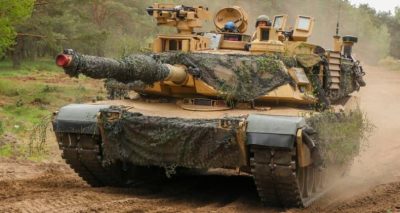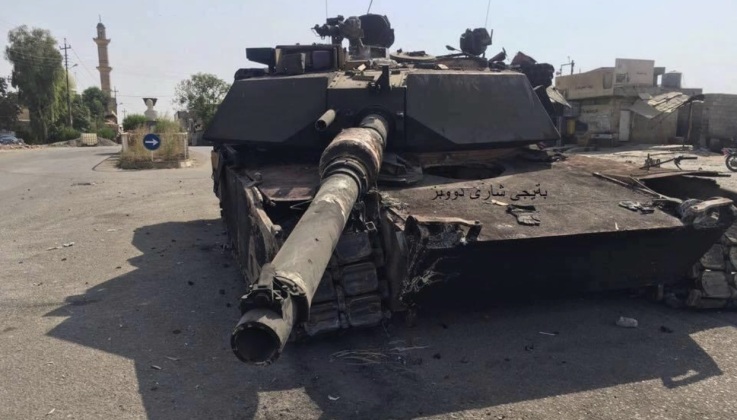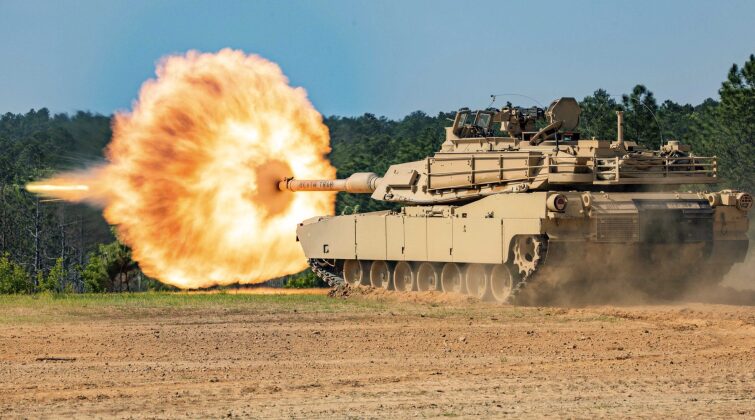Ukrainian Crews Complete Abrams Tank Training: U.S. Pledges Depleted Uranium Shells for Offensive

All Global Research articles can be read in 51 languages by activating the Translate Website button below the author’s name.
To receive Global Research’s Daily Newsletter (selected articles), click here.
Click the share button above to email/forward this article to your friends and colleagues. Follow us on Instagram and Twitter and subscribe to our Telegram Channel. Feel free to repost and share widely Global Research articles.
***
The first Ukrainian tank crews have completed training to operate American M1 Abrams battle tanks, after approximately 200 Ukrainian personnel began training at U.S. Army facilities in Germany earlier in the year. The last stages of training at the Hohenfels Training Area, the home of the U.S. Army’s Joint Multinational Readiness Center, included a combined arms force on force exercise simulating operations at battalion strength. Washington pledged to supply 31 Abrams tanks to support Kiev’s ongoing war effort against Russia, with U.S. Army Acquisition Chief Doug Bush having stated in August that the vehicles would arrive by “early fall,” indicating a delivery date before October. Reports from Politico indicate that the first 10 tanks will arrive in mid-September, with these vehicles “undergoing final refurbishments.” The United States has notably refused to provide its more capable M1A2 tanks, and is sending the older M1A1 which officials have stressed will have sensitive technologies removed. Although the U.S. Army retains very large reserves of Abrams tanks, refurbishing and downgrading the vehicles for export has proven to be time consuming.
Image: Iraqi Army M1A1 Abrams Destroyed By HJ-8 Missile

M1A1 tanks built for export have consistently suffered from a questionable combat performance, as demonstrated by their operations in Iraq and Yemen in Iraqi and Saudi hands. The tank’s combat record is nevertheless far less tarnished than that of its German counterpart the Leopard 2 which took heavy losses in Turkish Army hands against lightly armed militias in Iraq and Syria. More modern Leopard 2 variants have more recently taken significant losses in Ukraine as well. Where Ukrainian Abrams tanks will differ from those exported to the Middle East is that they will benefit from integration of depleted uranium munitions, with Reuters having reported just hours after confirmation that the first crew had completed training that Washington would supply such rounds. Britain has already supplied depleted uranium munitions to Ukraine, with Russian officials having issued harsh warnings in response. A notable example was the statement by the head of the Russian delegation to the Vienna Negotiations on Military Security and Arms Control Konstantin Gavrilov on January 25 that
“If Washington and NATO countries provide Kiev with weapons for striking against the cities deep inside the Russian territory and for attempting to seize our constitutionally affirmed territories, it would force Moscow to undertake harsh retaliatory actions. Do not say that we did not warn you.”
This was interpreted by some sources at the time to be an indication that nuclear weapons use was not being ruled out.
Image: M1 Abrams Tank Firing

Depleted uranium is one of the heaviest elements on the planet, and is made from low-level radioactive waste produced during the manufacture of nuclear fuel and nuclear warheads which makes it affordable to use in large quantities. Although it has been used in the armour of Abrams tanks, the M1A1s built for the Ukrainian Army will not have this armour the composition of which is a sensitive Pentagon secret, meaning they will be similarly vulnerable to even lower end anti armour weapons as Iraqi Army Abrams tanks have proven to be. Use of depleted uranium munitions has been highly controversial due to its highly detrimental effects on human health, with British Royal Navy Commander Robert Green having reported after the Gulf War a resulting “surge of unexplained illnesses, cancers and children born with genetic deformities among the Iraqi people, especially in the south near the battlefields” A confidential UN report leaked in May 1999 similarly concluded regarding depleted uranium weapons: “this type of ammunition is nuclear waste, and its use is very dangerous and harmful.” In the subsequent Iraq War the city of Fallujah was heavily bombarded using depleted uranium weapons, with Professor Chris Busby who participated in a survey of 4,800 Fallujah residents referring to a “major mutagenic exposure” causing effects “similar to that in the Hiroshima survivors who were exposed to ionising radiation from the bomb and uranium in the fallout.”
*
Note to readers: Please click the share button above. Follow us on Instagram and Twitter and subscribe to our Telegram Channel. Feel free to repost and share widely Global Research articles.
Featured image: U.S. Army M1 Abrams TankAndrew Greenwood (By Andrew Greenwood)

